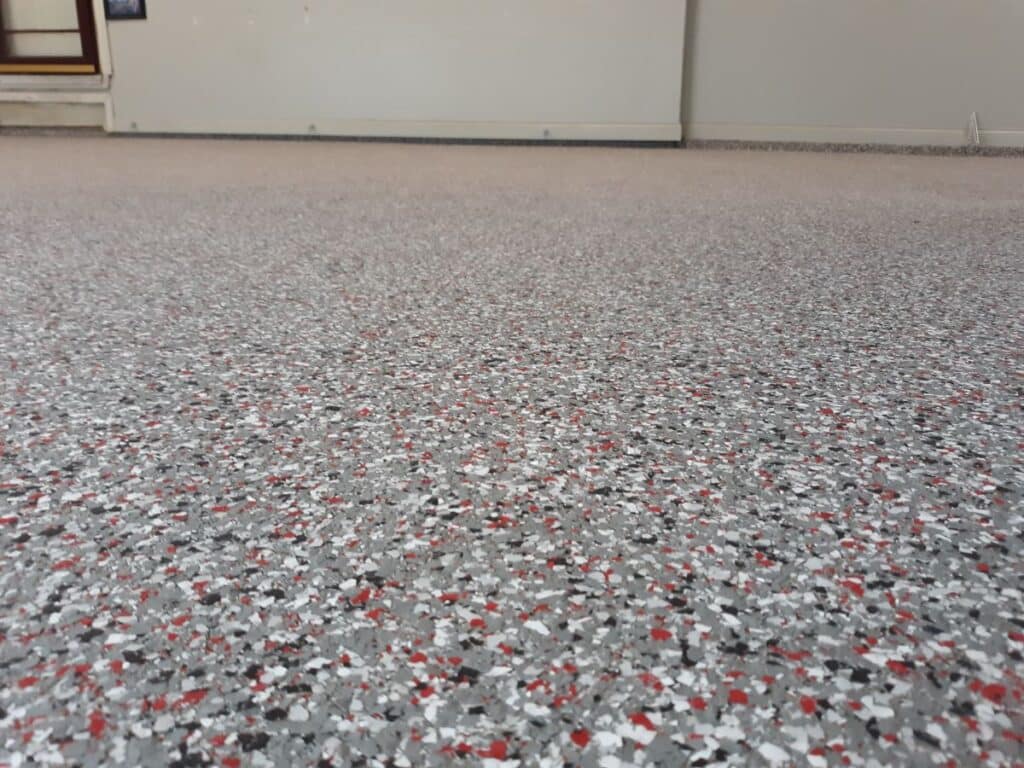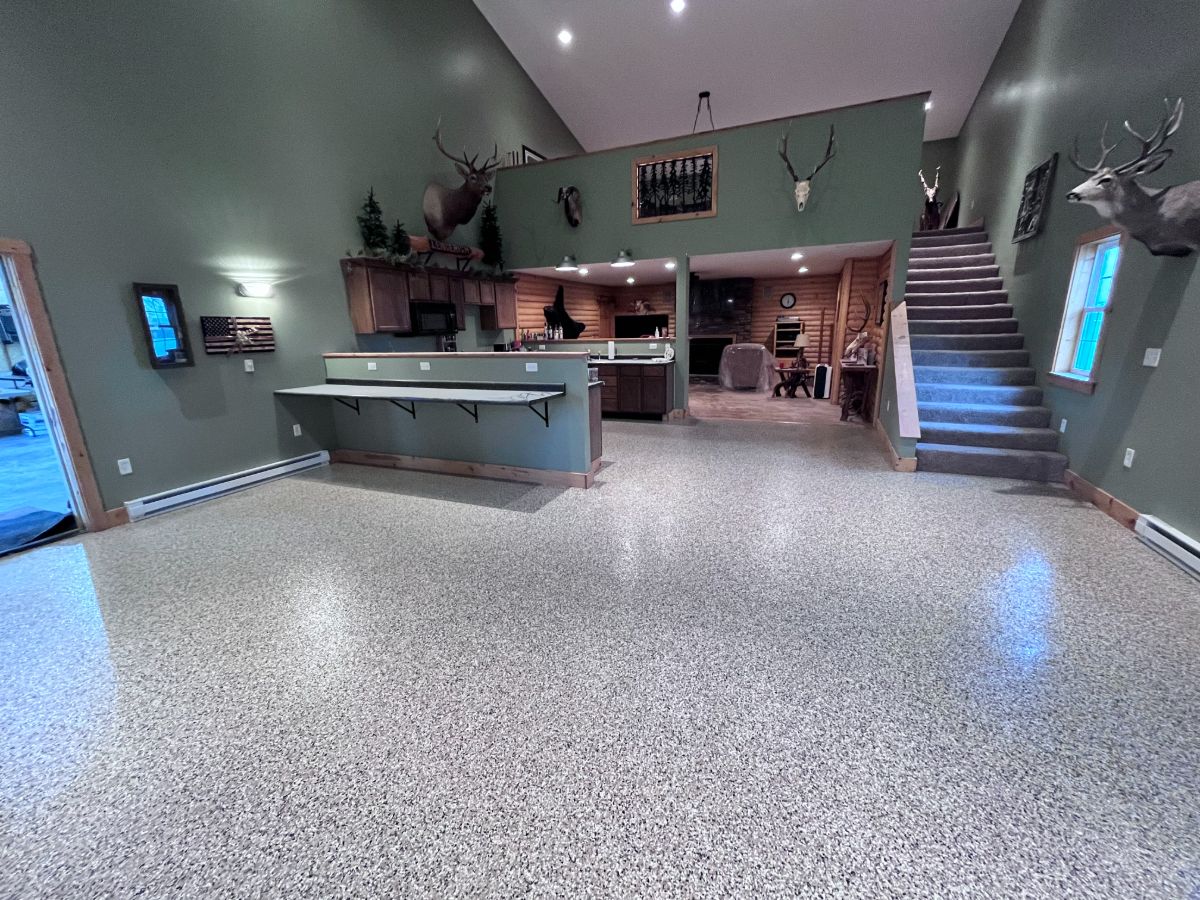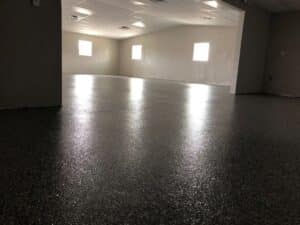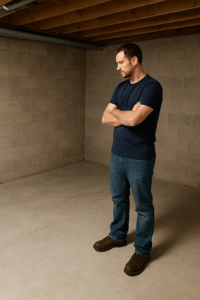First off, let’s clear something important up: while most people think of concrete floor coatings as “epoxy,” the reality is that most modern concrete coatings are actually made with a material called polyurea for the base coat and polyaspartic for the top coat.
While our prospective customers and clients often use the words interchangeably – and we will in this article – know that when we talk about an epoxy floor coating, we’re really talking about polyaspartic!
With that out of the way, let’s answer one of the most pressing questions we get from our prospective customers: how long will epoxy floor last?
Key Takeaways
- Polyaspartic coatings can last 10 to 20 years without re-coating if taken care of well and depending on how they are used and abused.
- Polyaspartic coatings outperform traditional epoxy in nearly every way. They cure faster, resist UV yellowing, hold up against hot tires, and last up to twice as long.
- Proper surface preparation is key. Grinding the concrete before application, repairing cracks, and working with an experienced, professional epoxy coating company will all help.

How Long Will Epoxy Floor Systems Last?
A well-installed epoxy flooring system can last anywhere from 10 to 20 years, depending on use, foot traffic, chemical exposure, and regular maintenance. Remember: polyurea and polyaspartic coatings offer the best lifespan, superior durability, and better outcomes in industrial floors and high-traffic areas.
So, What Affects Epoxy Floor Longevity?
- Surface Preparation: Good preparation is the foundation of a long-lasting floor coating. We grind your concrete floor with industrial-grade diamond grinders (rough pads), which are hooked up to vacuums to minimize dust. This is intended to create abrasions that make for better adhesion between the polyurea and your concrete.
- Crack and Pit Repair: A flawless finish starts with a smooth surface. We use Duralast crack filler to patch all damage before any coating does down, making sure the epoxy floor installed is totally seamless.
- Usage and Traffic Levels: Heavy traffic in commercial spaces and industrial settings will wear faster than a basement with a few kids running around, but that doesn’t mean it’s not worthwhile. Give us a call to talk about the specifics of your space and find out how your might hold up based on our experience.
- UV Exposure and Sunlight: Standard epoxy floor coatings tend to yellow with UV exposure, while our UV-stable polyaspartic topcoat keeps color crisp.
- Maintenance Practices: Simple habits, like using a soft mop and avoiding harsh chemicals or aggressive acids, will extend the lifespan of your floor coating.

Epoxy vs. Polyurea & Polyaspartic: A Side-by-Side Comparison
So what’s the difference between epoxy and polyaspartic? Both are two-ingredient resins that, when combined, begin to harden. But there are some serious drawbacks to the older epoxy formulas.
- Lifespan: A standard epoxy floor can last a decade, but polyurea/polyaspartic coatings can double the lifespan.
- Installation and Curing Time: Epoxy flooring systems require days to cure, while polyaspartic coatings are ready for foot traffic within about 24 hours.
- UV Stability: Unlike traditional epoxy coatings, which will yellow and fade over time and sunlight exposure (that means garages and daylight basements!), polyaspartic topcoats resist UV light, and prevent yellowing.
- Improved Resiliency: Polyurea and polyaspartic are incredibly hard, but they have a little bit more flexibility than epoxy. That’s important because it allows the coating to move WITH the concrete as it naturally expands and contracts with changing seasons and moisture levels. That slight flexibility means it lasts longer without cracks or chips.
- No Risk With Hot Car Tires: Epoxy can also come apart under heat, namely where warm car tires rest on it day after day. That leads to chips and peeling. Polyaspartic does not have this problem.
Our Step-By-Step Process for a Long-Lasting Floor Coating
Step 1: Surface Preparation
We start by grinding the concrete floor, eliminating salt, oil, and grime to properly prepare the surface for coating adhesion.
Step 2: Repairing the Concrete
Any cracks or pits are sealed using Duralast crack filler, followed by additional grinding to create an even and smooth surface.
Step 3: Base Coat Application
A thick layer of Duralast’s 100% solid pure polyurea base coat locks onto the concrete, offering unmatched strength and adhesion.
Step 4: Full Broadcasting of Decorative Chips
Once the base coat is down, we scatter color chips by hand to create a slip-resistant and nice-looking finish.
Step 5: Scraping and Cleaning
After the base coat dries, we scrape the floor with steel blades to remove loose chips, followed by vacuuming to maintain a clean surface.
Step 6: Polyaspartic Top Coat
Finally, we roll out the UV-stable polyaspartic topcoat, sealing in the decorative chips and providing lasting protection against heavy traffic.
Ready for a Floor That Lasts? Contact Dream Floors Concrete Coatings Today!
A properly installed floor coating lasts longer with proper preparation, proper care, and regular maintenance.
If you’re tired of cracks, stains, and a dirty concrete floor, it’s time for a beautiful and hassle-free professional concrete coating. At Dream Floors Concrete Coatings, we install high-quality flooring options that outperform traditional epoxy flooring systems in every way.
Want a floor that lasts? Reach out today for a free concrete coating quote and let’s get started!
We do:
Professional garage floor coatings
Professional basement floor coatings
Industrial and commercial concrete coatings (commercial kitchens, garages, and more!)
Common Questions About Epoxy Flooring Systems
How long does epoxy last in a garage?
Our concrete floor coatings in a garage typically last 10-20 years, depending on traffic and use patterns.
Are epoxy floors high maintenance?
Epoxy floors require gentle cleaning, but little else. They may need to be re-coated every 10-15 years. Polyaspartic will last longer and look better.
What are the disadvantages of epoxy flooring?
Epoxy floors can yellow from UV exposure, chip under heavy impact, take days to cure, and may need frequent re-coating in busy areas.
How much does it cost to epoxy a 2-car garage?
The cost to epoxy a 2-car garage ranges from $5000 to $10,000, depending on the quality of the concrete. Give us a call for a free quote!





